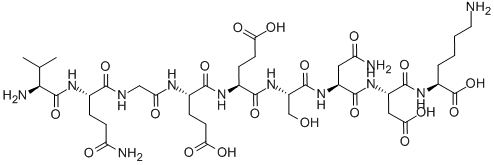Uses
β-Interleukin I (163-171), human, an immunostimulatory fragment of human IL-1β peptide, is a T cell activator. β-Interleukin I (163-171), human is not an IL-1R-binding domain of IL-1β. β-Interleukin I (163-171), human is a potent adjuvant that enhances the immune response in a variety of exptl. situations[1][3][4].
Biological Activity
β-interleukin i (163-171), human(c39h64n12o19), a peptide with the sequence val-gln-gly-glu-glu-ser-asn-asp-lys, mw= 1005. interleukins are a group of cytokines (secreted proteins/signaling molecules) that were first seen to be expressed by white blood cells (leukocytes). interleukin 1 alpha and interleukin 1 beta (il-1 alpha and il-1 beta) are cytokines that participate in the regulation of immune responses, inflammatory reactions, and hematopoiesis.interleukin-1 beta (il-1β) also known as catabolin, is a cytokine protein that in humans is encoded by the il1b gene. il-1β precursor is cleaved by caspase 1 (interleukin 1 beta convertase). cytosolic thiol protease cleaves the product to form mature il-1β. il-1β is a member of the interleukin 1 cytokine family. this cytokine is an important mediator of the inflammatory response, and is involved in a variety of cellular activities, including cell proliferation, differentiation, and apoptosis.figure1 formula of b-interleukin i (163-171), humanfigure2 structure of b-interleukin i
Biochem/physiol Actions
IL1B (interleukin 1 β) is an immune-activating cytokine. In presence of infection or cell stress, it gets converted into active mature form.
in vivo
β-Interleukin I (163-171), human (50 μg, daily, a poorly immunogenic fibrosarcoma (CE-2) of BALB/c mice model) induces a consistent but limited inhibition of tumor growth[2].
β-Interleukin I (163-171), human (1 μmole/kg, i.v.) together with the T-dependent antigen SRBC increases the primary immune response against the antigen[3].
References
1. Contassot E, Beer HD, French LE (2012). "Interleukin-1, inflammasomes, autoinflammation and the skin". Swiss Med Wkly 142: w135902. Matzinger P (2012). "The evolution of the danget theory. Interview by Lauren Constable, Commissioning Editor". Expert Rev Clin Immunol 8 (4): 311-7.3. Sahoo M, Ceballos-Olvera I, del Barrio L, Re F (2011). "Role of the inflammasome, IL-1β, and IL-18 inbacterial infections". ScientificWorldJournal 11: 2037-50.
